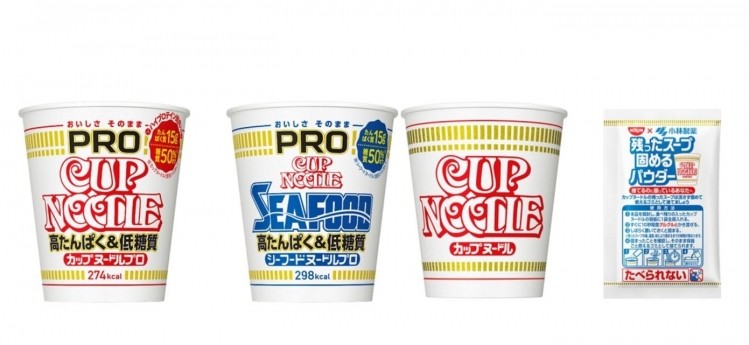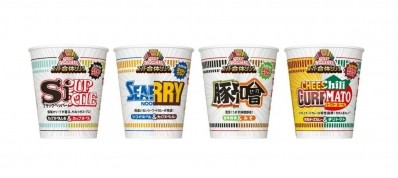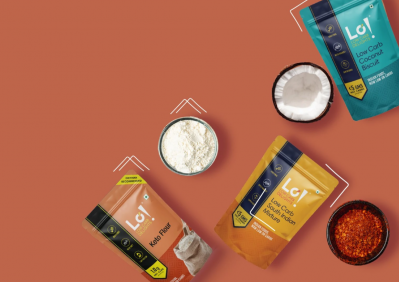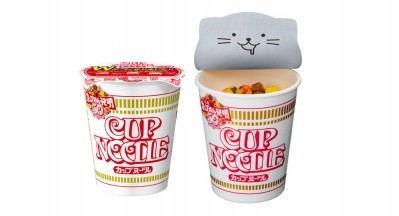Solid gold: Nissin innovates to mark 50th anniversary of Cup Noodle with high-protein products and solidifying powder for leftover soup

Nissin invented the world’s first cup-type instant noodles (Cup Noodles) in 1971, and one of its latest innovations is Japan’s first high protein and low carbohydrate range called Cup Noodles Pro, available in original or seafood flavours.
Makoto Watanabe, chief of marketing division at Nissin Food Products, explained that the range was created due to growing health consciousness among consumers in Japan.
“Recently in Japan, the importance of protein as a nutrient has attracted attention, and the market for protein enriched foods has expanded significantly. In addition, the low-carb market continues to grow year by year.”
Cup Noodles Pro (Original) contains 15.2g of protein and 15.3g of sugar. The non-Pro version contains 10.5g of protein and 44.2g of sugar.
For the Cup Noodles Pro (Seafood), it contains 15.2g of protein and 18.2g of sugar, while the non-Pro version contains 8.9g of protein and 43.5g of sugar.
Watanabe told FoodNavigator-Asia: “Adding nutrients such as protein to foods generally has a significant effect on taste. Therefore, it can be difficult to achieve a delicious instant noodle that is also rich in protein.”
This led to the firm embarking on a year-long R&D process for the Pro range.
To increase protein content, Nissin achieves these by blending collagen peptide in the soup.
In addition, the Pro range (original) contains its High Protein Mystery Meat which contains 1.8 times more protein than regular Mystery Meat.
Mystery Meat is a hybrid of flavoured soy-based and animal-based meat, combined with vegetables.
Carbohydrate reduction was mainly through the noodles, using a method called low-carbohydrate three-layer frying. In this method, dietary fibre is kneaded into the inner layer together with the frying process in oil, followed by drying. This lowered the saccharide levels, resulting in lower carbohydrate content.
The Pro range is sold in Nissin’s online store, supermarket and convenience stores nationwide.
Soup powder
In another development, Nissin Food Products and Kobayashi Pharmaceutical collaborated to create a powder to solidify leftover soup in cup noodles, making it easier to dispose.
According to Watanabe, the powder contains a high water-absorbent resin that is often used for diapers and a bittering agent to prevent accidental ingestion.
Consumers can tip the powder into the remaining soup, stirring for 10 seconds, and leaving it to solidify.
The solidified soup can then be thrown away as burnable trash along with the paper cup in which it is contained.
Watanabe said: “Cup Noodles is still our number one brand after all these years. It be eaten anytime and anywhere, at the comfort of your home, at the office, even outdoors. The convenience of being able to eat-on-the-go no matter where you are, is what makes this product so popular.
“However, many consumers have a bit of trouble when it comes to disposing the leftover soup. We have been aware for some time that this leftover soup becomes an issue when you are outdoors or at the office because it’s difficult to find an appropriate place to get rid of the soup.”
“This will make it easier for consumers to consider cup noodles as an eating option.”
The powder is developed for solidifying leftover soup for nine cup noodle products, including original, curry, seafood, chilli tomato, miso, salt, cheese curry, spicy tonkotsu and tom yum kung. These variants are only sold in Japan.
The powder comes with every applicable product purchased on Nissin’s online store. The firm is also planning to give out powder sachets at several camp sites in Japan, supposedly where cup noodles are confirmed frequently, yet lack the necessary waste disposal for leftover soup.
Nissin does not plan to sell the powder as a stand-alone product, nor export it.























